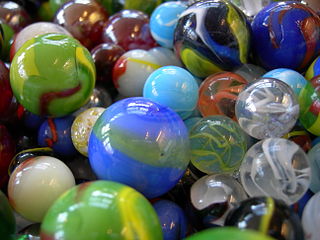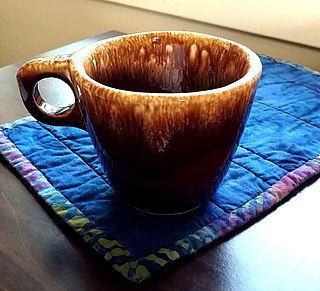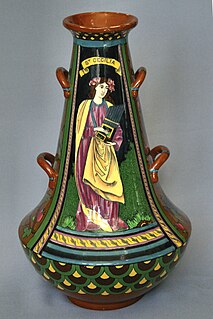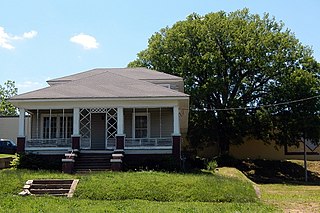
Porcelain is a ceramic material made by heating substances, generally including materials such as kaolinite, in a kiln to temperatures between 1,200 and 1,400 °C. The strength and translucence of porcelain, relative to other types of pottery, arises mainly from vitrification and formation of the mineral mullite within the body at these high temperatures. Though definitions vary, porcelain can be divided into three main categories: hard-paste, soft-paste, and bone china. The category that an object belongs to depends on the composition of the paste used to make the body of the porcelain object and the firing conditions.

A marble is a small spherical object often made from glass, clay, steel, plastic, or agate. They vary in size, and most commonly are about 13 mm in diameter. These toys can be used for a variety of games called marbles, as well being placed in marble runs or races, or created as a form of art. They are often collected, both for nostalgia and for their aesthetic colors.

Spode is an English brand of pottery and homewares produced by the company of the same name, which is based in Stoke-on-Trent, England. Spode was founded by Josiah Spode (1733–1797) in 1770, and was responsible for perfecting two extremely important techniques that were crucial to the worldwide success of the English pottery industry in the century to follow.
North Dakota in the United States has been the scene of modern era pottery production using North Dakota clays since the early 1900s. In 1892 a study was published by Earle Babcock, a chemistry instructor at the University of North Dakota (UND) that reported on the superior qualities of some of the North Dakota clays for pottery production. The UND School of Mines began operations in 1898 with Earle Babcock as director. With the assistance of several eastern potteries, pottery made from North Dakota clay was first displayed at the 1904 St. Louis World's Fair.

Hard-paste porcelain, sometimes "true porcelain", is a ceramic material that was originally made from a compound of the feldspathic rock petuntse and kaolin fired at very high temperature, usually around 1400 °C. It was first made in China around the 7th or 8th century, and has remained the most common type of Chinese porcelain.

Bone china is a type of ceramic that is composed of bone ash, feldspathic material, and kaolin. It has been defined as "ware with a translucent body" containing a minimum of 30% of phosphate derived from animal bone and calculated calcium phosphate. Bone china is the strongest of the porcelain or china ceramics, having very high mechanical and physical strength and chip resistance, and is known for its high levels of whiteness and translucency. Its high strength allows it to be produced in thinner cross-sections than types of porcelain. Like stoneware, it is vitrified, but is translucent due to differing mineral properties.
W. Moorcroft Limited is a British art pottery manufacturer based at Burslem in Stoke-on-Trent, England. The company was founded by William Moorcroft in 1913.

Metlox Pottery, strictly speaking Metlox Manufacturing Company, was a manufacturer of ceramic housewares, located at 1200 Morningside Drive, Manhattan Beach, California. The pottery factory closed in 1989.

Mintons was a major company in Staffordshire pottery, "Europe's leading ceramic factory during the Victorian era", an independent business from 1793 to 1968. It was a leader in ceramic design, working in a number of different ceramic bodies, decorative techniques, and "a glorious pot-pourri of styles - Rococo shapes with Oriental motifs, Classical shapes with Medieval designs and Art Nouveau borders were among the many wonderful concoctions". As well as pottery vessels and sculptures, the firm was a leading manufacturer of tiles and other architectural ceramics, producing work for both the Houses of Parliament and United States Capitol.

Hull pottery began production in 1905 in Crooksville, Ohio, under the leadership of Addis Emmet (A.E.) Hull. The Hull Pottery Company's early lines consisted of common utilitarian stoneware, semi-porcelain dinnerware and decorative tile. The company quickly established a firm market and enjoyed an excellent reputation for producing quality ceramics.
The Fiesta Tableware Company is a ceramics manufacturer located in Newell, West Virginia, United States. Established in 1871, it is widely known for its Art Deco glazed dinnerware line, Fiesta.

The Roseville Pottery Company was an American art pottery manufacturer in the 19th and 20th centuries. Along with Rookwood Pottery and Weller Pottery, it was one of the three major art potteries located in Ohio around the turn of the 20th century. Though the company originally made simple household pieces, the Arts and Crafts–inspired designs proved popular, and Roseville pieces are now sought after by collectors.

J.A. Bauer Pottery is an American pottery that was founded in Paducah, Kentucky in 1895 and operated for most of its life in Los Angeles, California. It closed in 1962.

Vernon Kilns was an American ceramic company in Vernon, California. In July 1931, Faye G. Bennison purchased the former Poxon China pottery renaming the company Vernon Kilns. Poxon China was located at 2300 East 52nd Street. Vernon produced ceramic tableware, art ware, giftware, and figurines. The company closed its doors in 1958.

Shelley Potteries, situated in Staffordshire, was earlier known as Wileman & Co. which had also traded as The Foley Potteries. The first Shelley to join the company was Joseph Ball Shelley in 1862 and in 1896 his son Percy Shelley became the sole proprietor, after which it remained a Shelley family business until 1966 when it was taken over by Allied English Potteries. Its china and earthenware products were many and varied although the major output was table ware. In the late Victorian period the Art Nouveau style pottery and Intarsio ranges designed by art director Frederick Alfred Rhead were extremely popular but Shelley is probably best known for its fine bone china “Art Deco” ware of the inter-war years and post-war fashionable tea ware.
Achelous and Hercules is a 1947 mural painting by Thomas Hart Benton. It depicts a bluejeans-wearing Heracles wrestling with the horns of a bull, a shape the protean river god Achelous was able to assume. The myth was one of the explanations offered by Greco-Roman mythology for the origin of the cornucopia, a symbol of agricultural abundance. Benton sets the scene during harvest time in the U.S. Midwest.

Seto ware is a type of Japanese pottery, stoneware, and ceramics produced in and around the city of Seto in Aichi Prefecture, Japan. The Japanese term for it, setomono, is also used as a generic term for all pottery. Seto was the location of one of the Six Ancient Kilns of Japan.

The Charles "Bullet" Dean Hyten House is a historic house at 211 South Main Street in Benton, Arkansas. It is a single-story Bungalow-style structure, with a hip roof that extends over its front porch. The porch is supported by square columns set on brick piers, with decorative metal latticework between the columns. Built in 1922, the house significant as the only surviving house associated with Charles Hyten and Niloak pottery. Hyten and Arthur Dovey together created a pottery process in 1909 that achieved swirling of different colors and types of clay, yet held together without shattering when baked in a kiln. The process was patented by Hyten in 1928. It was the basis of the Arts and crafts movement-era Niloak's Art pottery line.

American art pottery refers to aesthetically distinctive hand-made ceramics in earthenware and stoneware from the period 1870-1950s. Ranging from tall vases to tiles, the work features original designs, simplified shapes, and experimental glazes and painting techniques. Stylistically, most of this work is affiliated with the modernizing Arts and Crafts (1880-1910), Art Nouveau (1890–1910), or Art Deco (1920s) movements, and also European art pottery.

The J. B. Owens Pottery Company, informally known as Owens Pottery, was an American art pottery and tile company that flourished for a few years around the turn of the 20th century.
















